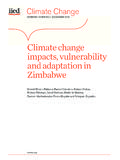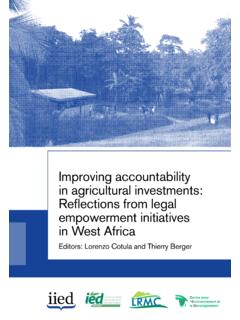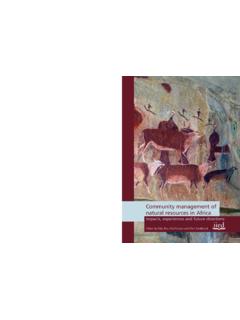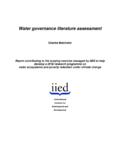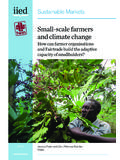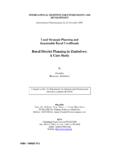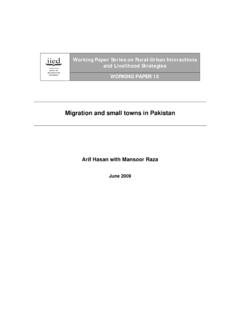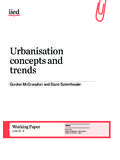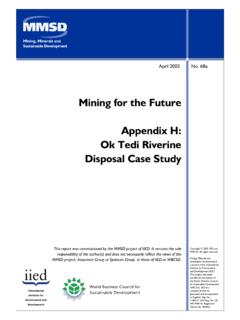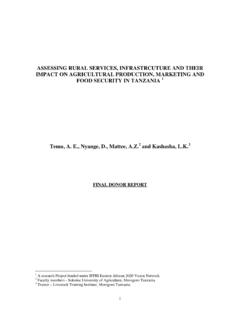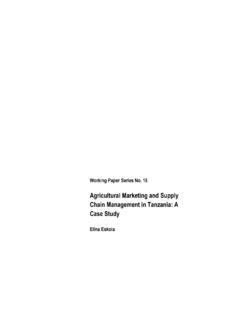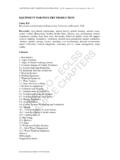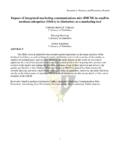Transcription of HUMAN SETTLEMENTS WORKING PAPER No.37 RURAL …
1 INTERNATIONAL INSTITUTE FOR ENVIRONMENT AND DEVELOPMENT. HUMAN SETTLEMENTS WORKING PAPER RURAL - urban interactions AND LIVELIHOOD strategies . urban poverty, food security and climate change by CECILIA TACOLI with BUDOOR BUKHARI and SUSANNAH FISHER. MARCH 2013. HUMAN . SETTLEMENTS . GROUP. urban poverty, food security and climate change Cecilia Tacoli with Budoor Bukhari and Susannah Fisher March 2013. ABOUT THE AUTHORS. Cecilia Tacoli is the Co-Group Head of the HUMAN SETTLEMENTS Group at IIED. Email Budoor Bukhari is an urban development researcher and graduate of the Development Planning Unit, University College London. Email Susannah Fisher is a Researcher in the Climate Change Group at IIED. Email ACKNOWLEDGEMENTS. This PAPER has been funded by UK Aid from the UK Government. IIED 2013. HUMAN SETTLEMENTS Group International Institute for Environment and Development (IIED). 80-86 Gray's Inn Road London WC1X 8NH, UK. Tel: 44 20 3463 7399 Fax: 44 20 3514 9055.
2 ISBN: 978-1-84369-914-9. This PAPER can be downloaded free of charge from Disclaimer: The findings, interpretations and conclusions expressed here do not represent the views of any organisations that have provided institutional, organisational or financial support for the preparation of this PAPER . ii Table of Contents BOXES, FIGURES AND TABLES .. iii ACRONYMS ..iv ABSTRACT ..iv Introduction .. 1. food security and food systems: concepts and definitions .. 1. The current global dimensions of food insecurity .. 3. The impacts of climate change on food systems .. 4. urban and RURAL , or net food buyers and net food producers?.. 6. The impact of urbanisation on food prices .. 7. urban expansion and the loss of agricultural land .. 9. The health impacts of urban food 11. Income poverty and food insecurity .. 14. The non-income dimensions of urban poverty: space, time and food insecurity .. 18. 19. References .. 20. Recent Publications by IIED's HUMAN SETTLEMENTS Group.
3 24. BOXES, FIGURES AND TABLES. Table 1: Dimensions of food security 2. BOX 1: The impacts of the 2008 rice price fluctuations on different groups in Vietnam 7. Figure 1: Population growth in urban and RURAL areas of main world regions, 1950 . 2025 8. Figure 2: RURAL and urban incidence of hunger ( food -energy deficiency) 9. Table 2: Estimates of average built-up area (in m2) per person for different regions, income groups and city size groups, 1990 2000. 10. Figure 3: Difference between the lowest and highest quintile ( RURAL areas) 11. Figure 4: Difference between the lowest and highest quintile ( urban areas) 12. Table 3: Diarrhoea prevalence in lower and upper urban socio-economic groups 12. Figure 5: Infant and under-five mortality rates in Kenya 13. Table 4: Percentage of urban children stunted 13. Box 2: Impact of the current economic crisis on urban informal-sector workers 15. Table 5: food expenditure as a proportion of total income by income tercile in 11 southern African cities 14.
4 Table 6: Household monthly income and selected expenditure by village in Mathare, Nairobi 16. iii ACRONYMS. APHRC African Population and Health Research Center CCAFS Climate Change, Agriculture and food Security FAO food and Agriculture Organization of the United Nations IFAD International Fund for Agricultural Development IFPRI International food Policy Research Institute IIASA International Institute for Applied Systems Analysis IMECHE Institution of Mechanical Engineers IPCC Intergovernmental Panel on Climate Change SREX IPCC Special Report on Managing the Risks of Extreme Events and Disasters to Advance Climate Change Adaptation UNDESA United Nations Department of Economic and Social Affairs UNFPA United Nations Population Fund UNDP United Nations Development Programme WFP World food Programme WIEGO Women in Informal Employment: Globalizing and Organizing ABSTRACT. The high and volatile food prices that triggered a renewed interest in food security since the 2008 09 crisis are expected to continue due to several factors that include the impacts of climate change.
5 Current policy prescriptions focus on food production; however, a broader approach based on food systems is more appropriate as it encompasses all aspects of food production, storage, distribution and consumption, all of which will be affected by climate change and especially by the growing frequency and severity of extreme weather events. As most low-income groups in both RURAL and urban areas are net buyers of food , access and affordability are central concerns. There is also a need for more attention to urban food security. While more than half of the world's population now live in urban centres and on average benefit from higher incomes and better living conditions than RURAL residents, there is also considerable inequality between wealthier groups and the residents of low-income and informal SETTLEMENTS . Low and irregular incomes are the root cause of urban food insecurity, but inadequate housing and basic infrastructure and limited access to services contribute to levels of malnutrition and food insecurity that are often as high if not higher than in RURAL areas.
6 They also increase exposure and sensitivity to the impacts of climate change and affect the ability to build resilience. Effective policies need to address urban food insecurity in both its income and non-income dimensions, and their impact on gendered disadvantage. iv Introduction The steady increases in food prices that culminated in the spikes of 2007 08 have brought food security back on the global policy agenda. Climate change, population growth, inefficient markets, the unsustainable use of natural resources and consumption patterns converge in putting pressure on current and future food availability and access. But while there is a growing interest in food systems that encompass all dimensions from production to final consumption, most policy prescriptions focus on addressing RURAL food production and tend to neglect the crucial importance of access and affordability for low-income groups and more specifically for poor urban residents. food insecurity is closely connected to poverty; throughout the world, RURAL poverty remains deeper and more widespread than urban poverty.
7 With the rapid urbanisation of low- and middle-income countries, however, poverty is increasingly located in urban areas and this will continue as virtually all global population growth in the next three decades is expected to be in cities and towns of Africa and Asia. Given urban residents' dependence on food purchases, food insecurity will increasingly become an urban issue. Low-income urban residents in low- and middle-income countries are also likely to be the most vulnerable to the increase in the frequency and severity of extreme weather events such as heat waves, floods and cyclones. This, in turn, will have a negative impact on their incomes, both by increasing expenditure and reducing their ability to earn; it will also exacerbate non-income dimensions of poverty related to inadequate living conditions. In addition, the links with relatives and kin in home areas that often provide safety nets for both RURAL and urban households, including transfers and exchanges of food and cash, are likely to be affected by the disruptions caused by environmental change.
8 The adverse impacts of the food prices crisis on low-income urban residents have been described extensively; there is also a growing literature that examines the consequences of climate change on agricultural production and, to a lesser extent, on transport and storage systems. To date, however, there have been few attempts to understand the links between climate change and urban food insecurity, albeit with some notable exceptions (Ziervogel and Frayne, 2011; Frayne et al., 2012). One obvious reason for this is that shocks and stresses of various kinds economic, political, and environmental and at different scales global, national, city-wide, community-wide and at the household and individual levels . are ever present in the lives of people living in low-income urban SETTLEMENTS . Such shocks and stresses interact and have a cumulative effect that makes it difficult to attribute their impacts to any specific event. The aim of this PAPER is to build on current understandings of urban poverty and urban food insecurity to explore how the impacts of climate change are likely to exacerbate current and future challenges.
9 The focus is on purchased food rather than own production through urban and peri- urban agriculture, although the latter is an important topic so much so that it deserves much more space that can be accommodated in this PAPER . The PAPER also deals very briefly with the other important issue of RURAL urban linkages; this is also a topic that deserves specific attention, and is the focus of another WORKING PAPER in this series. food security and food systems: concepts and definitions food security has been a development and equity concern for many decades. As Amartya Sen pointed out over three decades ago, starvation is the characteristic of people not having enough food to eat. It is not the characteristic of there being enough food to eat' (Sen, 1981). The definition that is still most widely used was coined at the 1996 World food Summit. It states that food security exists when all people, at all times, have physical, social and economic access to sufficient, safe and nutritious food that meets their dietary needs and food preferences for an active and healthy life' (FAO, 2006).
10 The most notable difference 1. between this definition and pre-1996 ones is the shift from a narrow focus on food production to a broader conceptualisation that encompasses four key dimensions: availability, access, utilisation and stability. The emphasis now is thus not only on food supply but also on physical access and affordability, and safety and nutritional balance, as well as socially and culturally determined preferences (FAO, 2003). Table 1: Dimensions of food security Physical AVAILBILITY of food availability addresses the supply side of food security food and is determined by the level of food production, stock levels and net trade. Economic and physical An adequate supply of food at the national or international ACCESS to food level does not in itself guarantee household level food security. Concerns about insufficient food access have resulted in a greater policy focus on incomes, expenditure, markets and prices in achieving food security objectives.
